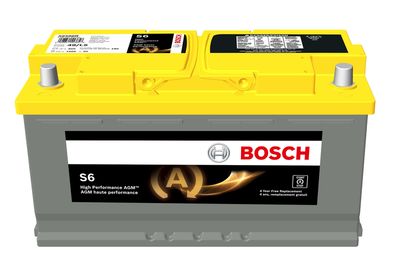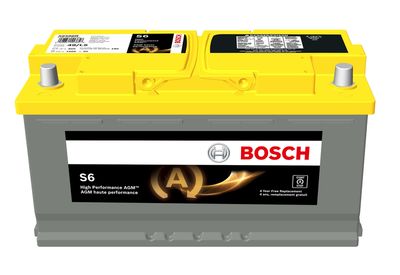Answer
Aug 23, 2024 - 08:05 AM
Using a Bosch battery tester with a Bosch S6588B Vehicle Battery is a straightforward process. Bosch battery testers are designed to assess the health and performance of car batteries, including those with AGM (Absorbed Glass Mat) technology like the S6588B. Here’s how you can use a Bosch battery tester to test the S6588B battery:
1. Prepare for the Test- Safety First: Ensure the vehicle is off, and the keys are removed from the ignition. Wear safety gloves and goggles to protect yourself from any potential acid exposure or sparks.
- Clean the Battery Terminals: If the battery terminals are dirty or corroded, clean them with a wire brush or terminal cleaner. This ensures a good connection between the tester and the battery.
- Check the Tester: Make sure the Bosch battery tester is charged or has fresh batteries (if applicable). Familiarize yourself with the tester’s manual and controls.
- Attach the Clamps:
- Red Clamp: Connect the red (positive) clamp of the tester to the positive (+) terminal of the Bosch S6588B battery.
- Black Clamp: Connect the black (negative) clamp to the negative (−) terminal of the battery.
- Ensure a Secure Connection: Make sure the clamps are securely attached to the battery terminals, with good contact to avoid inaccurate readings.
- Select Battery Type: On the Bosch battery tester, select the appropriate battery type. For the S6588B, choose the AGM (Absorbed Glass Mat) option.
- Input CCA Rating: Enter the Cold Cranking Amps (CCA) rating of the Bosch S6588B. This rating is usually found on the battery label. If you’re unsure, refer to the battery’s specifications or consult the vehicle’s owner’s manual.
- Initiate the Test: Once the tester is properly set up, initiate the test by pressing the appropriate button or selecting the "Test" option on the tester’s menu.
- Wait for the Results: The tester will assess the battery’s voltage, CCA, and overall health. This process typically takes a few seconds to a minute.
- Voltage Reading: A fully charged AGM battery like the Bosch S6588B should read around 12.6 to 12.8 volts when the vehicle is off.
- CCA Reading: The tester will compare the actual CCA reading against the battery’s rated CCA. A significant drop in CCA might indicate that the battery is aging or has a problem.
- Battery Health: The tester will give an overall assessment of the battery’s health, often displayed as "Good," "Weak," or "Replace."
- Charging System Check: Some testers also have the capability to check the vehicle's charging system, ensuring the alternator and voltage regulator are working properly.
- Start the Engine: If your tester has a function to check the charging system, you may be instructed to start the engine.
- Rev the Engine: The tester might ask you to rev the engine to a certain RPM to check how the alternator charges the battery under load.
- Review the Results: The tester will indicate whether the charging system is operating within normal parameters.
- Turn Off the Tester: After you’ve reviewed the results, turn off the battery tester.
- Remove the Clamps: Disconnect the black (negative) clamp first, followed by the red (positive) clamp.
- Store the Tester: Store the battery tester in a safe, dry place.
- Good Condition: If the battery is in good condition, no further action is needed.
- Weak Battery: If the battery is weak, you might consider recharging it or monitoring it closely for signs of failure.
- Replace Battery: If the tester indicates that the battery needs to be replaced, consider getting a new battery to avoid potential starting issues.
Using a Bosch battery tester with a Bosch S6588B Vehicle Battery is an effective way to monitor the battery’s health and ensure it’s performing optimally. By following the steps outlined above, you can quickly assess the condition of your battery and take appropriate action if needed. Regular testing can help prevent unexpected battery failures and ensure reliable vehicle operation.





Add New Comment